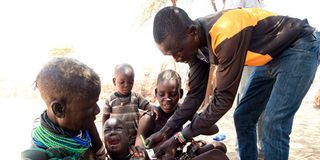25 counties are experiencing worsening nutrition crisis, shows report

A child is screened for malnutrition at Kanamkuny village,Turkana County on October 11, 2022.
What you need to know:
- Garissa, Kilifi, Kwale, and Tana River are in the “alert” drought phase, signaling potential risks if conditions do not improve.
A recent report by the National Drought Management Authority (NDMA) has highlighted a concerning trend in the nutrition situation across the country.
The lastest report by the authority indicates that 52 per cent of counties are experiencing a worsening nutrition crisis, as evidenced by a growing proportion of children falling into the "at-risk" category for malnutrition.
Some of the counties that recorded worsening trends include Garissa, Isiolo, Mandera, Samburu, Tana River, Wajir, Kilifi, Kitui, Kwale, Makueni, Meru, and Tharaka Nithi.
On the other hand, the counties that reported stable conditions include Turkana, Embu, Laikipia, Narok and West Pokot.
According to the NDMA, the deteriorating situation in these counties is largely due to reduced milk production and consumption at the household level. Other factors that contributed to the worsening trend include dietary diversity, inadequate food intake, and poor childcare practices, which combined and eventually heightened vulnerability among children, exacerbating malnutrition rates.
"The worsening trend in the counties was as a consequence of reduced milk production, hence consumption at household level, poor
dietary diversity, inadequate food intake, and poor childcare practices," the authority said in the report.
The report further revealed that approximately 39 per cent of counties are facing worse nutrition conditions compared to the usual situation for this time of year. This is attributed to limited outreach activities that usually provide essential nutrition services and elevated morbidity rates in affected regions.
"Approximately 39 per cent of the counties reported a nutrition situation that was worse compared to the usual situation at such a time of the year, and that could be attributed to the limited number of outreach activities
delivering essential nutrition services coupled with the high morbidity rates," said NDMA.
However, the report highlighted a positive update where the general price of cattle was stable and good across most counties due to the stable livestock body condition occasioned by pasture and water availability
While the body condition of livestock remained stable across all reported counties, the authority noted that the delayed onset of the October-November-December rains in most counties poses a risk to the body condition of all livestock species.
Meanwhile, the current stability was primarily attributed to the availability of quality, palatable forage in adequate quantities within the usual grazing zones near households, combined with relatively shorter trekking distances to water sources due to the good recharge of open water structures in the previous season.
Based on the range of early warning indicators monitored through the drought early warning system, 21 Arid and Semi Arid counties are at the 'normal' phase while two counties - Kilifi and Kwale - are at ‘alert’ drought phase.
Livestock keepers, especially pastoralists, had witnessed massive decline in livestock productivity due to limited access to pasture and water points, and as a result, reproductive rates among cattle, goats, and sheep plummeted. This also caused a decline in herd sizes and milk production, and effects like malnutrition were evident.
In the aftermath of three consecutive years of severe drought, pastoralists in some Asal regions are still grappling with dwindling milk production, exacerbating their already precarious livelihoods.


